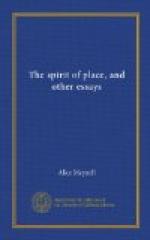Time was when no good news made a journey, and no friend came near, but a welcome was uttered, or at least thought, for the travelling feet of the wayfarer or the herald. The feet, the feet were beautiful on the mountains; their toil was the price of all communication, and their reward the first service and refreshment. They were blessed and bathed; they suffered, but they were friends with the earth; dews in grass at morning, shallow rivers at noon, gave them coolness. They must have grown hard upon their mountain paths, yet never so hard but they needed and had the first pity and the readiest succour. It was never easy for the feet of man to travel this earth, shod or unshod, and his feet are delicate, like his colour.
If they suffered hardship once, they suffer privation now. Yet the feet should have more of the acquaintance of earth, and know more of flowers, freshness, cool brooks, wild thyme, and salt sand than does anything else about us. It is their calling; and the hands might be glad to be stroked for a day by grass and struck by buttercups, as the feet are of those who go barefoot; and the nostrils might be flattered to be, like them, so long near moss. The face has only now and then, for a resting-while, their privilege.
If our feet are now so severed from the natural ground, they have inevitably lost life and strength by the separation. It is only the entirely unshod that have lively feet. Watch a peasant who never wears shoes, except for a few unkind hours once a week, and you may see the play of his talk in his mobile feet; they become as dramatic as his hands. Fresh as the air, brown with the light, and healthy from the field, not used to darkness, not grown in prison, the foot of the contadino is not abashed. It is the foot of high life that is prim, and never lifts a heel against its dull conditions, for it has forgotten liberty. It is more active now than it lately was—certainly the foot of woman is more active; but whether on the pedal or in the stirrup, or clad for a walk, or armed for a game, or decked for the waltz, it is in bonds. It is, at any rate, inarticulate.
It has no longer a distinct and divided life, or none that is visible and sensible. Whereas the whole living body has naturally such infinite distinctness that the sense of touch differs, as it were, with every nerve, and the fingers are so separate that it was believed of them of old that each one had its angel, yet the modern foot is, as much as possible, deprived of all that delicate distinction: undone, unspecialized, sent back to lower forms of indiscriminate life. It is as though a landscape with separate sweetness in every tree should be rudely painted with the blank—blank, not simple—generalities of a vulgar hand. Or as though one should take the pleasures of a day of happiness in a wholesale fashion, not “turning the hours to moments,” which joy can do to the full as perfectly as pain.




